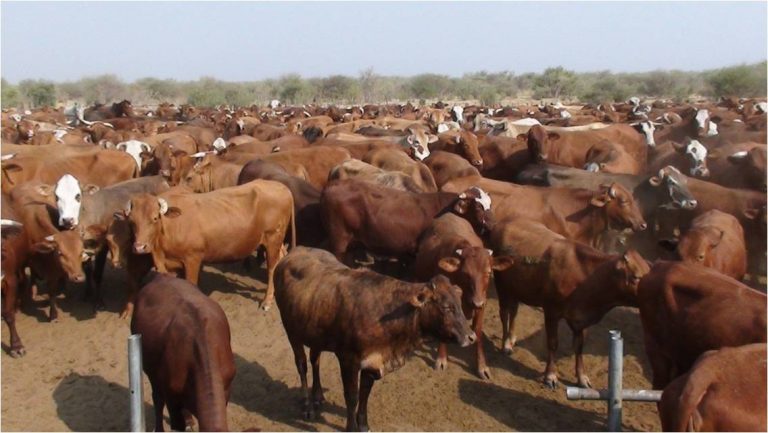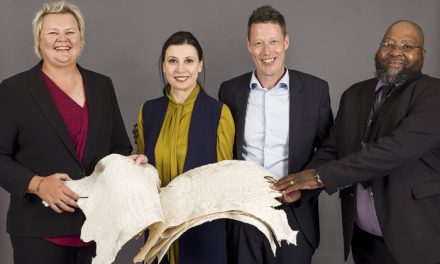
How the red meat industry can benefit from international markets?

By Helmke Sartorius von Bach.
Development of the local cattle industry: – Cattle production in Namibia is one of the oldest forms of livelihood. Cattle are raised for beef production, draft power for crop production or as a means of asset accumulation. Only in the past half century, was the weaner production system introduced.
The Namibian national cattle herd reached its peak in 1970 when there were three times as many cattle south of the Veterinary Cordon Fence than currently. Already at that time, Namibia was a net exporter of cattle with 312,383 live cattle exported to South Africa, 75,219 cattle slaughtered in local factories, and 31,295 cattle processed in local butcheries. The offtake rate was low as production was much higher than local demand.
However, as export logistics improved, opportunities opened to build local abattoirs and after 1990 the export of beef cuts to the European Union became a given.
The access to foreign beef markets stimulated growth at home through value addition and benefits from foreign exchange rates. This was the time when the push economy changed into a demand-pull system for Namibian beef. The latter is more efficient, because farming activities adjust to actual demand, it increases productivity and also profitability. Furthermore, it allows for optimization of resources by reducing the possibility of overstocking.
By 1997, farmers became price responsive and Namibian cattle production became known for being raised on natural pasture for most of the animals’ lives without the use of hormones or routine antibiotics, and mostly compliant to consumer preferences. The initiative originated from the Meat Board of Namibia, who played a significant role to structure the industry. It resulted in abattoirs achieving relative constant slaughter throughput by applying price adjustments. These positive changes all contributed to the many positive multiplier effects on the economy originating from an improving cattle sub-sector.
The value of the cattle industry to local economy: – The focus was placed on quality, best practices and genetics. The livestock sector grew and contributed to GDP but during the past 6 years, its started to decline. Research shows that real cattle production increased until 2007, concurrently when livestock total factor productivity reached its peak, and thereafter declined to half in 2021. Farmers were forced to reduce the herd size because of unsuitable rangeland practices during drought, leading to weakening profitability. Institutional changes in secondary value chains, impacted the profitability of the farmer, and further reduced the number of cattle marketed annually.
More pressure on slaughter prices: – Graph 1 below shows the deflated prices for both the weaner and slaughter animals. It can be observed that the real carcass prices started to decline in 2011 which resulted in cash flow problems, higher unemployment on farms, and lower investments in farming. Collectively, these factors contributed to a declining rural economy. Cashflow pressure resulted in a situation where many farmers switched from ox production to the weaner system as weaner prices became favourable in Namibia, prompted by feedlot developments in South Africa. Only after the first outbreaks of foot and mouth disease in South Africa has the weaner system increasingly come under pressure, especially since January 2021.
GRAPH 1

International price differences: – International food traders source beef from all over the world to equalize supply and demand. However, the equilibrium depends on the specific requirements, which are based on health and processing regulations, which allows or restricts access to higher priced beef cuts. Beef cuts thus need to follow activities in vertically coordinated value chains from farm to fork. Activity in this value chain, typically includes design, production, marketing and support to get the final product to the end consumer, obviously steered by the changing consumer needs.
Only once all role players in this vertical chain are paid, and took their cut, the producer is paid. This producer price is known as price per kilogram for a specific grade. A comparison of beef producer prices was done for different large beef exporting countries, competing to supply the same final consumer destinations. Namibian beef exports are only a small component in that bigger picture, and are currently used by intermediaries in the international market to fill supply gaps.
The producer price comparison between countries was based on similar weight slaughter cattle and producer prices were changed to the Namibian currency for comparability. From Graph 2 a relative decrease of Namibian beef prices is seen, vis-à-vis global trends. The development of the Namibian cattle industry suffered, as beef producer prices became less attractive for farmers. This trend of losing its competitive advantage, is attributed to high fodder costs, production risks and even land degradation.
GRAPH 2

Findings from the price comparison: – All these countries share access to the same markets. Therefore the specific value chain selected to market the countries’ beef determines the monetary value available to pay their farmers. The high producer prices are thus a function of shortening chains, of cost efficiency and strategic marketing. It has to be noted that these drivers allowed the Australian cattle industry to pay producer prices double what Namibian cattle farmers received in the past two years.
Conventional trading lowered Namibian abattoir throughputs. Deflating the above prices, the average prices increased at a steady rate of 4.8% annually, which is double the annual growth rate for the Namibian beef producer price. This is a clear sign that Namibian farmers lost their comparative advantage. Prices paid to countries’ beef producers differed as their industries are supported differently. The average nominal growth rate over the years was the highest for Australia (12.9%), followed by the USA, the EU, Argentina, Uruguay and Brazil. The lowest was for Namibian beef farmers with 7.47%. It can be observed that the beef price cycle still exists, namely that a low was found in 2012, followed 7 years later in 2019 and probably again in few years to come. The low price altitude can be tracked back starting in 1972.
Call to premiumize: – Graph 2 portrays the Namibian cattle industry not embracing international opportunities to tap into benefits for the local stakeholders. Beef farmers and processing facilities have not migrated to focusing on expanding into premium and quality assurance to capture value chain benefits, which offset the processing and logistical costs, and to provide tangible value gains for their producers, as was done by its international beef competitors. Time is ripe for an adjustment industry strategy in Namibia to focus on premium and quality assurance, to tap into value chain benefits in premium markets. This will multiply economic revival in the sub-sector, and inject cash flow into rural economies where the sustenance for more than 400,000 households is created.
Historic abattoir demand curve: – To assess the local situation Graph 3 was plotted with deflated producer prices to reflect economic change over time by deflating them to current circumstances (2023=100). Annually since 1995, the beef demand was almost close to elastic, meaning that a 10% price change resulted in an opposite 7.2% change in cattle throughput indicating that farmers responded to price signals. Furthermore, during the off-season, the abattoirs increased prices by 10% to stimulate low supply during the months October to February to stabilize the abattoir slaughter throughput by 3%. A demand curve with this slope shown below is a sign of responsiveness to market signals.
GRAPH 3

The beef industry responding – ox production suffering: – Around 2011 changes in the industry resulted in a decline of the real Namibian beef producer prices. International real beef producer prices continued to grow by 6% annually, but this growth was not channelled back to the Namibian producers, while local cattle production costs were soaring.
Profitability came under pressure. – When the weaner real prices showed increased growth in 2014, many farmers were forced to switched from ox production to weaner production to maintain a positive cashflow. The price ratio of the weaner to beef carcass slowly increased from a relative stable 63% to its maximum of 92% in January 2021. Farmers gained on short term cashflow options, by receiving 92% of the final carcass price within 7 months, rather than waiting 27 months to obtain a further 8%. In this market trend ox production declined, and farmers are caught in a cycle of weaner production. The consequence was that abattoirs’ throughputs declined by 80% between 2016 and 2021 and only a few ox producers were left to supply the abattoirs. But oxproducers experienced a steady decline in real producer prices compared to international producers.
A rigid pricing strategy for slaughter animals can be blamed for the decline, especially since world market prices continued to prosper. The consequence was that the above demand curve flattened significantly to the curve seen below, since 2021.
GRAPH 4

Choose between commodity supply or premiumization: – The flat demand curve in Graph 4 is a sign of a rigid throughput strategy and portrays farmers losing their price responsiveness again. This shape of the current demand curve is comparable to the years from the early 1980s to mid 1990s.
However, those were times when farmers benefitted from agricultural subsidies and were generally not under cashflow pressure. Product payment was received within a week. The flat curve above is a threatening sign, representing inefficiency in making use of opportunities. Stagnant prices often portray conditions of a reduced number of intermediaries to allow for competition, often resulting in the likelihood of losing product quality by offering a lower price. The industry, which achieved such a lot, should be cautioned not to allow consumer trust in the properties of Namibian beef to be lost, fostering commodity supply as opposed to premiumization of the Namibian product.
The weaner cycle: – Weaner prices were never as high as in the past few years. It resulted in large numbers of animals intended to become slaughter cattle, to be sold as weaners instead. Namibia lost value addition for the economy to grow. Once a farmer become a weaner producer, it is difficult to reverse the production system. The producer will typically market the calves once they are weaned between 5 and 8 months. Therefore, the breeding season determines the numbers of weaners available at the monthly auctions. Most weaners enter the market in the winter months. Graph 5 shows that the demand curve was relative inelastic, with an elasticity of -0.25, for the period prior to 2021.
GRAPH 5

Since the correction of the weaner to carcass price ratio in January 2021 in Graph 1, the prices paid for weaners at auctions declined. This was based on external changes after the outbreak of foot-and mouth disease in South Africa. It forced many feedlots to reduce their purchases, and agents often colluded to form alliances and bid based on fixed price principles. The demand curve shown in Graph 6 below became marginally flatter, showing that auction throughput became less of a function of price, but more driven by farmers’ cashflow requirements. Furthermore, the low incentives provided for beef producers reduce competition on the auctions. It only benefits feedlots in neighbouring countries while reducing growth at home.
The small change in the slope of the demand curve after the significant price drop, shows that the weaner system is probably not ideal for local cattle farmers, if analyzed using the national averages. In reality however, auction prices for the same quality and type differ by location. Prices are guided by the transport costs to the final feedlot destination, and to a lesser degree receive a premium for quality and homogenous lots.
GRAPH 6

An assessment was made to show how essential it might become to compare demand curves for auction locations. Deflated prices over time were plotted for Gobabis and Grootfontein – see Graph 7. One would expect that auction prices closer to the South African market would be higher than those further away. In general, this might be the case, but more interesting is that price trends play a more significant role at the Gobabis auction than at the Grootfontein auction. This can be seen by comparing the slopes of the trend lines.
Like the national weaner price averages, both trend lines show a decline. The current deflated weaner prices at many auction facilities already reached values below N$30/kg. The main reasons for the decline of weaner prices may be the poor rainfall, but also the failure of the veterinary measures in South Africa to control further foot-and-mouth outbreaks. One can only speculate whether real price decline could reach price levels of N$20/kg live weight. The current weaner price paid to farmers compares to prices received in the mid-2010s and at some areas with smaller auction cattle, it compared the situation in the mid-2000s. The consequences are obvious.
GRAPH 7

Premiumize and turn the tide: – Namibian beef has a reputation for superb quality and in compliance with all regulatory measures; however, it still has not reached its full prima potential to reach even higher and consistent standards in meeting satisfaction levels and to become a preferred beef globally. Current consumer surveys shows that most Namibian beef lose their brand of origin once the trader places it on the final retail shelf. These beef cuts are marketed as commodity beef, and the premium properties are not rewarded.
International consumers consistently indicate that they are willing to pay a premium for Namibian beef properties, especially because of the taste and the quality. Therefore, a future different marketing strategy should assure producers and ensure that Namibian cuts reach the retail shelf, and not allow underpayment. Namibia must become a niche beef producer again.
Best practices are within reach: – Consumer surveys point out that once Namibian beef is guaranteed as grass-fed, it will receive further premiums. Therefore, the Namibian industry is called to ensure that best practices both on the farm and the export abattoir are followed. It implies that the existing traceability system additionally capture data during slaughter, cut processing, packaging, pelleting, and dispatching, until the individual cuts reach their final destination. Market research shows that the demand for the quality Namibian beef can offer, exceeds the production of Namibian prime beef by far. The development of opportunities therefore depends on furthering the interests of the industry in dealing with overseas governments and in multilateral negotiations for beef brokers to act in the interest of the Namibian industry to obtain the best return possible, taking into consideration all cuts.
Knowledge is power: – For many years, Namibian farmers have selected their best production practices to survive and successfully run their farms. However, not only those practices have changed, now farmers also need to become institutionally intelligent, by understanding how institutions work and to adjust accordingly to meet timelines.
On the international side, more emphasis is placed on compliance in traceability, food safety, and animal welfare. Certification procedures set the basis for sustainable beef trade and allows Namibian cuts to enter certain markets. Therefore, cattle producers should start to take responsibility to focus on improving their herds, with the aim to improve the beef quality. This could be done by applying genetic principles to optimize cutability and palatability, and thereby to reduce the inconsistency of the eating quality to the consumer.
Further research will be required to genetically select for predictor criteria to improve beef tenderness and carcass quality attributes, to improve feed utilisation efficiency and to reduce methane emissions for cattle, and to comply to minimize any pre-harvest stress. Pre-harvest stress is a condition where the glycogen is depleted from the muscle tissue, which results into a high final muscle pH, causing undesirable dark color of beef cuts.
For the Northern Communal Areas in particular, the industry need to re-install and maintain the previously established traceability system, which would put NCA’s beef in a position to earn a revenue related to the value of their carcasses traded. The demand for traceable and superior beef originated from NCAs should be marketed based on their commodity-based trade specifications. This will improve production to quality levels demanded by end-users. It is obvious that this re-installation of a previous system can improve prices, to benefit the rural communities at large.
With the 4th Industrial Revolution, information should be generally available. Therefore, cattle farmers need to follow a system to produce only when there is an actual demand for their products or services. This has to be supported by an enabling regulatory environment and supported by extension services, to especially support those farmers in need for upliftment. The heterogenous quality of products and processes requires attention to become compliant to consumer needs and to optimize expenses. Since the production systems are partly influenced by geological area constraints, farmers who need to compensate for soil deficiencies, especially in the Kalahari sand plateau and to a lesser extend in the Kalkveld agro-ecological zones, will be forced to continue with weaner production, but incentivized through higher prices paid for improved homogeneous quality. Therefore, the weaner production system will remain an obvious choice and alternative for many farmers in a free Namibian market.
Prepared for climate change: – Climate change will pose a significant threat to the Namibian beef industry in future. Farming risks will increase, resulting in the possibility that export abattoirs will continue to be underutilized and that live cattle will be exported to South Africa with the consequence of less beef exported to affluent markets and lower profits for the industry at all levels.
Therefore, a turn-around strategy needs to be followed that manages the treat of desertification. At the same time, Namibian farmers need to become aware of requirements that allow for significant higher prices obtained from local abattoirs. The extension services can play a significant role through workshops and training in directing correct pre-harvest practices necessary to comply with export criteria, resulting in the consistent classification of Namibian beef as superior. It all starts with humane cattle handling, cattle behaviour and the use of stress-free cattle infrastructure for healthy animals. Such practices will maintain profitability and allow for growth within the rural economy.
Price is dependent on quality: – The demand curves presented are based on the ceteris paribus assumption that the product is of similar characteristic. Once farming practices, beef processing and logistics improve by addressing consistent quality, health, traceability from farm to fork, animal welfare, slaughter facilities’ hygiene and processing to ensure quality guaranties, etc., the entire demand curve will shift to the right.
This is regarded as the starting point of uncovering hidden opportunities for efficiency and increased productivity. The quality changes need to be complemented by the beef brokers to ensure that Namibian beef becomes visually enhanced on the shelves.
Thus, Namibian beef brands must enter the final retail chain and it should not be allowed to sell Namibian properties as commodity beef. Only then, for the same quantity beef demanded, the consumers will pay significantly more per unit. Then, the complete vertically integrated value chain can share benefits and especially the farmers will be rewarded with improved producer prices. This is only possible with a strategic future direction. It will not only result in multiplier effects, but more importantly, it will become the catalyst to reverse the decline of the rural economy.













































